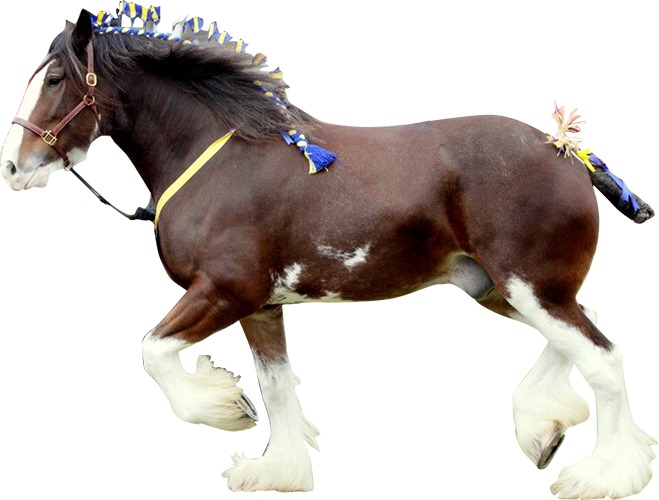Breed Standard & Registration

to meet modern requirements.

A good Shire Stallion should stand from 17.0 hands (173 cms) upwards, and weigh from 900 kg to 1100 kg when matured, without being overdone in condition.
COLOUR
HEIGHT
HEAD
EYES
NOSE
Slightly Roman, nostrils thin and wide; lips together.
EARS
THROAT
SHOULDER
NECK
GIRTH
BACK
LOINS
FORE-END
HIND-QUARTERS
RIBS
FORELEGS
HINDLEGS
Hocks should be not too far back and in line with the hind – quarters with ample width broadside and narrow in front. “Puffy” and “sickle” hocks should be avoided. The leg sinews should be clean cut and hard like fine cords to touch and clear of short cannon bone.
BONE
MEASUREMENT
FEET
HAIR
Both head and tail should be carried erect. The ribs should be well sprung, not flat sided, with good middle which generally denotes good constitution. A Stallion should have good feet and joints; the feet should be wide and big around the top of the coronets with sufficient length in the pasterns. When in motion, he should go with force using both knees and hocks, which latter should be kept close together, he should go straight and true before and behind. A good Stallion should have strong character.
Modification or Variation of Stallion Standard
of Points for Mares

COLOUR
HEIGHT
HEAD
EYES
NECK
GIRTH
152 cms to 214 cms (matured) according to size and age of animal.
BACK
LEGS
BONE
MEASUREMENT
She should have plenty of room to carry her foal.
Modification or Variation of Stallion Standard
of Points for Geldings

COLOUR
HEIGHT
GIRTH
From 183 cms to 229 cms.
BONE
MEASUREMENT
10 (23 cms) to 11 inches (26 cms) under knee, slightly more under hock and broadside on, of flat hard quality.
A Gelding should be upstanding, thick, well-balanced, and a very active and showy mover.
He should be full of courage and should look like and be able to do a full day’s work. Geldings weigh from 850 kg to 1100 kg.
Stud Book & Registration
The Parent Stud Book for Shire Horses was established in 1878 by the English Cart Horse Society. By the time the society changed its name to Shire Horse Society in 1883 the Stud Book was closed to Shires got by a registered Shire stallion and out of a registered Shire mare only. For about five decades registration numbers were huge – for example 699 Stallions and 3,408 females bred in the UK alone were entered in the 1916 Stud Book. From the late 1930s to the late 1950s horse numbers of all breeds declined due to a numbers of different reasons, and entries of UK bred Shires in the Stud Book fell steadily from 1102 females & 304 stallions in 1939 to 261 females & 76 stallions in 1947 to 11 females & 5 stallions in 1958. The Shire Horse survived those dark days, but was listed for decades on the Red List as almost extinct. Today the breed is still considered an endangered domestic breed.
22 stallions (including two bred in the UK but standing in Europe and four bred & standing in Europe) were registered in the Parent Stud Book in 2022 and 205 females (78% bred in UK, 6% in AUS, 1% in NZ and 15 % in other countries). This small population of Shires in the world bears the risk of increasing inbreeding and loss of genetic diversity, so it makes sense to keep as many Shire Horses as possible registered in the Parent Stud Book. Horses registered with the Parent Stud Book are eligible for any other Studbook in the world, but progeny of Shire horses registered with any other Studbook are not necessarily eligible for the Parent Stud Book. Shire breeders in Australia who register their horses with the Parent Stud Book could be enhancing genetic diversity in international Shire horse breeding offering access to Shire Horse bloodlines that are not or no longer available in other parts of the world. The other way to increase genetic diversity in the Shire Horse population is an open studbook.
In 1940, the Shire Horse Society decided to open the Stud Book with the introduction of the Grading-Up Register. In the early years, breeders were even urged if they had any mares or fillies, which lacked sufficient pedigree to enable them to be registered in the Stud Book, to enter them in the Grading-Up Register without delay.
The Grading-Up Register has two Books, with Register A open to females sired by a registered Shire stallion, and Register B open to females sired by a registered Shire stallion and out of a Grade A registered mare. In 1944, the B Register has also been opened to progeny of a registered Shire stallion and out of a registered Clydesdale mare. Since the very start of the Grading-Up Register all females by registered Shire stallions and out of dams entered in Register B are eligible for full and complete registration in Shire Horse Stud Book.
In 2022, Shire Horse Society has also introduced a new Part Bred Register. To be eligible for this new Register horses must have one registered Shire parent and one registered parent of another breed (excluding Clydesdale and SHS Grade A and B Registers which continue to operate under the existing Stud Book Rules). Certificates of service and DNA testing are required for Part Bred Registration. Progeny of horses registered in the new Part Bred Register will not be eligible for upgrading into the full register.

